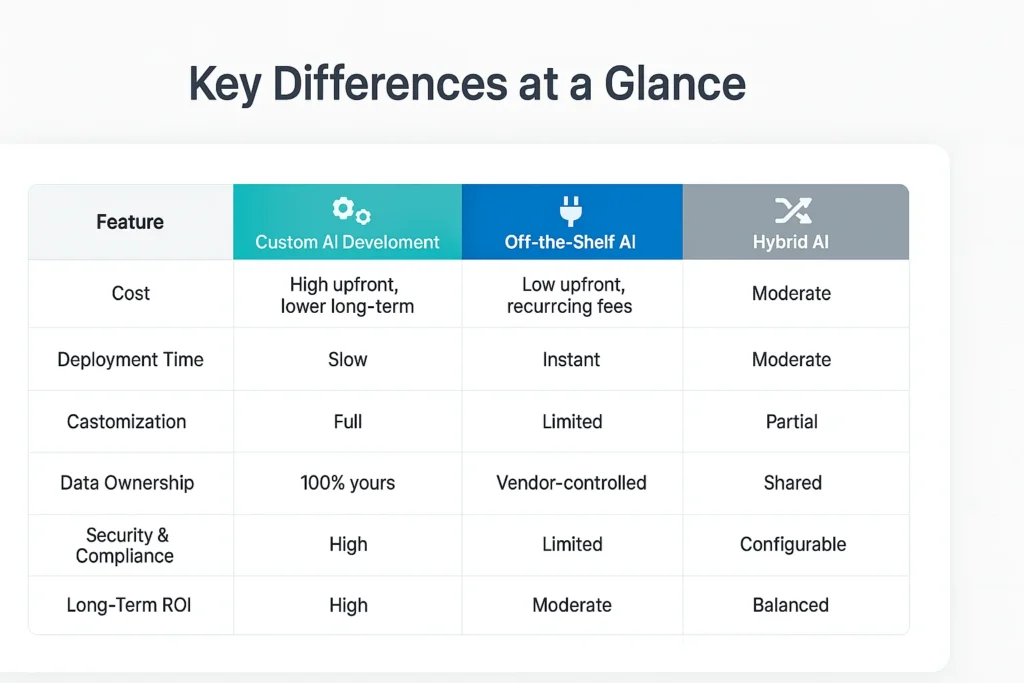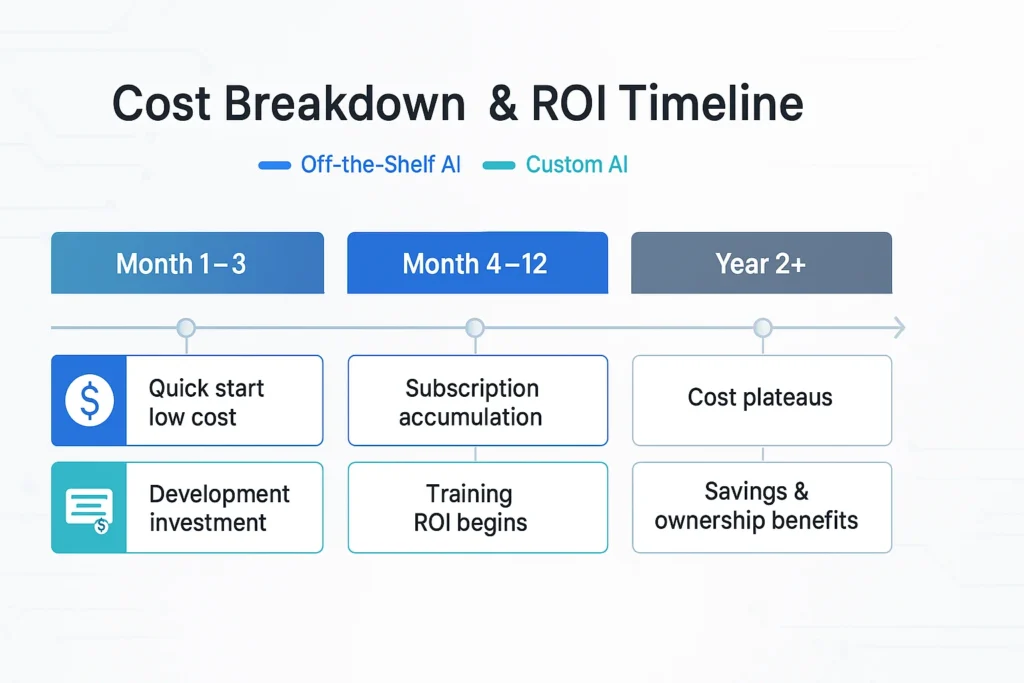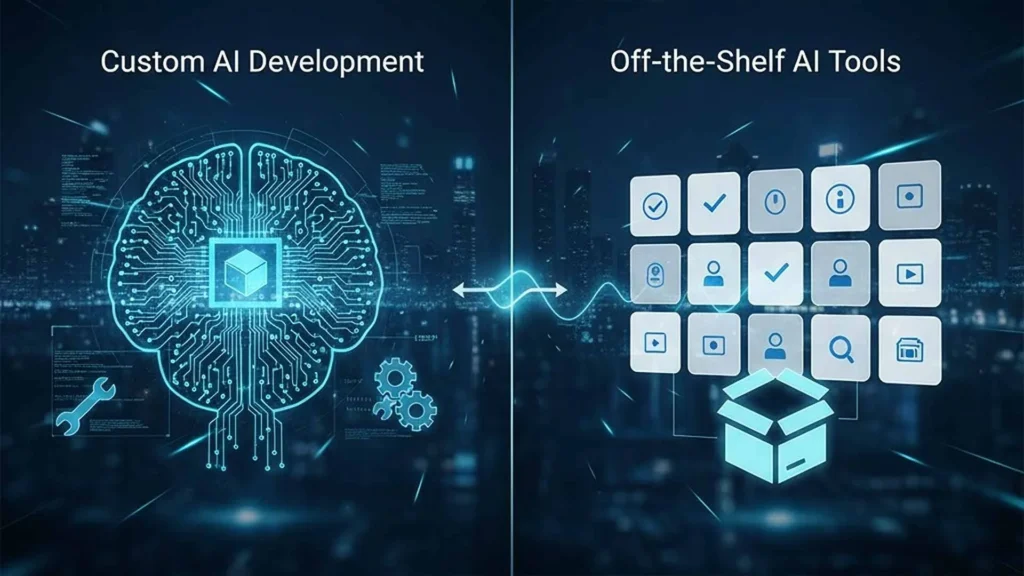You’ve tried ChatGPT. You’ve experimented with plug-and-play AI tools. But your business still needs deeper insight, cleaner data, and scalable automation. That’s the real difference between custom AI development vs off-the-shelf AI tools, one adapts to your business, the other expects your business to adapt to it. If off-the-shelf AI isn’t cutting it anymore, it’s time to think.
Understanding AI Development Approaches

What is Custom AI Development?
Custom AI Development is the process of creating and training artificial intelligence models specifically tailored to meet your business’s requirements. These systems are built from scratch using your proprietary data, workflows, and goals instead of relying on general-purpose models.
They are integrated deeply within your operations, giving complete control over model behavior and security, as well as scalability.
While custom AI takes longer to develop and requires more up-front investment, it offers higher accuracy, a domain more relevant to your company or department, and long-term return on investment for anything in enterprise-grade.
Best For:
- Organizations with complex or regulated processes
- Enterprises seeking competitive differentiation
- Businesses needing advanced data security and compliance
What Are Off-the-Shelf AI Tools?
Off-the-shelf AI tools are pre-built solutions specifically designed to deploy rapidly. They are ideal for businesses wanting to introduce AI into their organization without building the AI infrastructure by hand. These tools come in the form of APIs, SaaS platforms, or plug-ins for common tasks such as chat automation, image recognition, and predictive analytics.
They offer convenience and speed but frequently lack the depth and adaptability required for highly specialized uses. You sacrifice flexibility for price and availability.
Best For:
- Small businesses or teams needing quick results but not having large resources to invest Companies testing AI feasibility
- General-purpose automation or analytics tasks
The Hybrid AI Approach
Hybrid AI combines the scalability of off-the-shelf tools with the precision of tailored development. This enables enterprises to put pre-built models to work as a foundation, and then make them more accurate using their own data, private embeddings, or retrieval-augmented generation (RAG).
These approaches speed up time-to-market while allowing production control, privacy, and accuracy at a context-dependent level. For companies that need flexibility without constructing everything from the ground up, it is “the best of both worlds.”
Best For:
- Mid- to large-scale enterprises seeking faster innovation
- Business that want to blend vendor APIs with proprietary data
- Teams which need to balance the cost and speed of development
Are you prepared to see the impact custom AI could make on your business processes? We will be glad to create your next smart system together.
Custom AI Development vs Off-the-Shelf AI: Key Differences

Cost and ROI
Custom AI development requires a considerably higher initial investment than off-the shelf AI. Yet in the long run it outperforms cheaper options with superior returns based on ownership, scalability, and benefit gained from automation, among other things. Off-the-shelf AI costs less upfront and offers predictable monthly fees. But as performance bottlenecks emerge, it soon becomes indispensable. A hybrid AI strategy mixes all elements: cost control, together with gradual performance enhancement
Time-to-Market
Off-the-shelf AI is the fastest to install, plug-and-play in terms of integration, and displays prompt results. Tailoring development cycles to the customer’s specific needs means that custom AI take longer to be put into practice. Hybrid AI provides a midway point between speed of implementation and select customisation where it matters.
Scalability and Flexibility
Custom AI naturally grows in line with the firm’s expansion, adapting to changing data and evolving demands. Conversely, off-the-shelf products have their own restrictions on adaptability. Hybrid AI fills that gap by offering an expandable architecture built on standard models, adjusting as necessary to meet new requirements without tearing out all of the old stuff each time in the process of updating.
Data Ownership and Security
Custom AI ensures you have absolute control over storage, usage, and compliance for your data–an asset to industries that must conform strictly with legal regulations. By contrast, off-the-shelf AI usually relies on third-party controls for information handling, thereby harboring privacy risks. Hybrid AI permits secure data control within a premises setting whilst harnessing external AI elements.
Integration and Compatibility
Custom AI digs deep into legacy systems to entwine itself seamlessly into workflows. It is only by virtue of standardized APIs that off-the-shelf AI tools are limited and may, in some cases, need attachments. Hybrid AI, however, permits flexibility of integration with both fixed pieces and those that can be modified by an internal setting.
Intellectual Property and Vendor Lock-In
With custom AI, enterprise users retain ownership of the IP, algorithms, and data. Off-the-shelf AI systems lock users into the vendor’s ecosystem, tempting them to become dependent upon it. Hybrid AI provides partial autonomy, taking advantage of external APIs but also preserving internal data and proprietary layers.
Model Performance and Accuracy
Custom AI is uniquely precise across industry areas, having been trained on custom data to suit the distinctive objectives of a given company. Off-the shelf AI supplies accuracy which meets most common tasks. Hybrid AI sharpens standard models with customization specific to the company, enhancing any contextual accuracy without a need for full redevelopment.
Suggested: https://exrwebflow.com/exrwebflow-vs-traditional-agencies/
When to Choose Each Artificial Intelligence AI Approach?
When to Choose Off-the-Shelf AI?
Choose off-the-shelf AI when you value speed, affordability, and simplicity above all else. And it’s a sweet spot for start-ups or small teams who need AI capabilities immediately but can’t afford infrastructure or technical support. A pre-built tool is the fastest way to get basic chatbots, image recognition, speech-to-text or predictive analytics, but they really only work well if your business fits within its limited scope for tweaking and customization.
When to Choose Custom AI?
Choose custom AI if you find that standard AI tools cannot process your exclusive data, complex workflows, or regulatory requirements. If your company has gained a certain degree of market share, wants to improve accuracy and safeguard data or profits by its own hand, to develop customized AI is a very good choice. In the end though it can be to pay more up front than using off-the-shelf products, custom AI definitely aligns exactly with your business model and grows as you do. It provides a better return on investment in the long run.
When to Choose Hybrid AI?
Hybrid AI is best if you need both speed and control, and it fits perfectly at those instances where the two are often at odds. This approach combines vendor models that have been pre-trained with your own data and logic layers, so that rapid deployment of your product can be achieved without forfeiting either flexibility or compliance. Hybrid AI is the tool if recently, any organization is making a transition from off-the-shelf tools up to more specialized systems or if your team wants to adapt existing models to fit domain specific scenarios while still keeping costs down.
Cost Breakdown and ROI Analysis

Hidden and Indirect Costs
Although it may seem free at first, off-the-shelf AI actually carries hidden costs such as subscription escalations, integration fees, API limits, and vendor lock-ins. As usage grows, so do these unpredictable expenditures.
Custom AI may be expensive at the outset but it offers cost transparency and has two great edges expenses that one does not look quite as much to cut people out or communications. Hidden future dependency costs, compliance risk, and third-party charges could have been spared a careful step involving customization.
ROI Modeling and Long-Term Payoff
Off-the-shelf AI yields quick returns but dwindling long-term benefits as monthly fees and feature restrictions reduce value with time. Custom AI achieves a slower initial ROI but accumulates in the years that follow through automation efficiency, data control and scalability. Over the long term, ownership and optimization make custom AI the more profitable investment.
We, at EXRWebflow, create intelligent software solutions that combine the power of automation, data and AI innovation according to the specific needs of your business.
Industry Use Cases
Decision Framework: Choosing the Right AI Path

Step 1: Define Business Objectives
What specific issues do you want AI to solve and what kind of clear, measurable goals can you set? The clearer your purpose is, the easier it will be to make sure that each decision made is within reach of delivering value to the business.
Step 2: Assess Data Volume and Quality
Is your data sufficient, relevant and clean enough for AI models to be trained or fine-tuned with any efficiency?
Step 3: Evaluate Technical Expertise
Determine what skills and resources are available in your team, or be prepared to seek external partners for AI development management and integration projects.
Step 4: Calculate ROI and Budget
Development, deployment, maintenance “data flows” this position can be traded against how much more efficient, accurate and stable revenues are achievable in the future.
Step 5: Review Compliance and Security
Make sure your handling of data and privacy policies as well as the output from any AI meets industry regulations and ethical standards.
Step 6: Align with Growth Strategy
Choose the AI solution that best supports scalable business goals, innovation and the company vision.

Building Custom AI: The Development Lifecycle
Model Design and Architecture
This is the stage in the blueprint when data scientists and engineers set the AI system’s goals, select model types, and make architecture designs. It ensures that AI meets the business goals, performance requirements, and scalability demands from inception on.
Data Pipeline Development
A robust data pipeline is constructed to gather, clean up, and prepare the data in some way or other. This process provides automation of information flows and the maintenance of high quality; it also lets you keep your custom AI plant up-to-date with updates continuously coming out.
Model Training and Validation
Now the AI model learns from data that has been pre-treated with advanced algorithms. Continuous validation guarantees accuracy, eliminates bias and makes tactical fine-tuning ahead of deployment mindful all along doing so.
Deployment and Integration
The trained model has been integrated into existing business systems, cloud platforms or APIs. Deployment is all about smooth operation, low disruption of service, and making real-time conversation between AI and business processes a reality.
MLOps and Continuous Improvement
Post-deployment, MLOps (Machine Learning Operations) guarantee ongoing tracking combined with version control and prioritization work. The model will develop and be retrained in response to feedback loops to maintain accuracy even if it needs new information.

Don’t let sophisticated AI concepts stay ideas only; make them come true in a way that they can scale up with your business. Thus, reach out to EXRWebflow and get your next-generation AI solution built, integrated, and optimized.
Let’s Discuss Your Idea!
Strategic Takeaways
Custom AI development offers control, adaptability and value over the long term. While it requires a higher initial investment than off-the-shelf tools, its fine-tuned accuracy, scalability and controllers justify that outlay.
How EXRWebflow Helps Businesses Build or Integrate AI
By designing tailored architectures and integrating API-based automation, EXRWebflow can enable businesses to use not only custom but also mixed-mode AI solutions. Our approach weaves strategy, data and engineering together, transforming complex AI systems into practical business results.
Conclusion
Custom AI development is a commitment to innovation and the willingness to own. While off-the-shelf tools are useful for speed and convenience, in the final analysis, businesses that invest in custom AI obtain lasting competitive advantage, better governance of data, and solutions to fit their future strategy.


